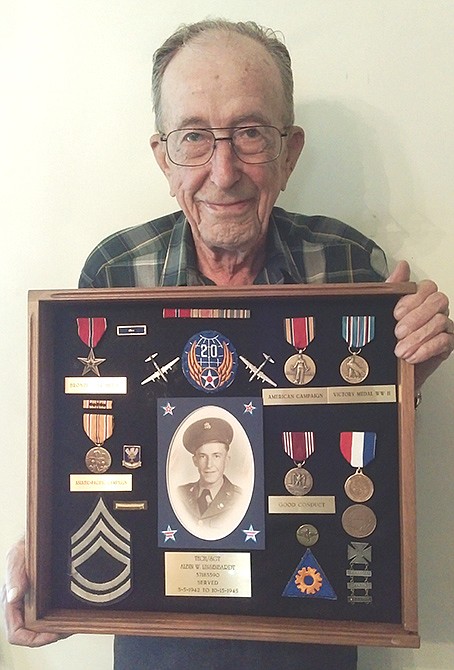Lohman veteran Albin "Al" Linsenbardt insists although every branch of the military would like to claim responsibility for winning the Second World War, it took every piece of the war machine pulling in unison to bring victory to the Allies.
As a member of the Army Air Corps during the war, Linsenbardt remains proud of his singular role as an aircraft crew chief on a small island in the Pacific.
"When I finished the eighth grade, I traveled to Chicago for six months of electrical training at Coyne Electrical School," said Linsenbardt, 97. "My dad was a carpenter and after working with him when I was younger, I decided that was too much work for me," he grinned.
Finishing the training in 1939, he worked on electrical motors at his uncle's shop in Jefferson City, but as the war erupted two years later, he decided to seek employment in the growing defense industry.
"I had a chance to go to work fixing electrical motors at Ft. (Leonard) Wood," Linsenbardt said. "I had been working there a couple of months when my draft notice finally arrived."
Humorously, the veteran recalled clinging to the belief he would be found "too skinny" for military service, but when reporting for his induction physical, he was told the military would "put the weight on you."
Shortly after beginning his basic training at Jefferson Barracks in May 1942, a call was made for volunteers to become aircraft mechanics. Based upon his experience working on electrical motors, Linsenbardt accepted the challenge.
"Two weeks into my basic training they sent me to Chanute Field, Illinois, and I completed airplane mechanic school and electrical specialist school," he explained. "Then they sent me down to Dale Mabry Field in Tallahassee, Florida, to work on combat aircraft."
Assigned to the 306th Fighter Squadron, Linsenbardt performed maintenance on the aircraft used to train combat pilots, such as the P-47 Thunderbolt and P-51 Mustang.
While stationed in Florida, Linsenbardt married his fiancée Jackie, believing he was at a "permanent base since pilots were training there all the time."
But in October 1943, he received orders for Lowry Field, Colorado, to undergo a month of training on the operation of .50 caliber machine guns and the 20mm cannons used aboard bombers.
Linsenbardt was transferred to Great Bend, Kansas, in November 1943 to learn the maintenance and repair of the B-29 Superfortress - a propeller-driven heavy bomber - while assigned to the 498th Bomb Group.
"We only had one B-29 assigned to the entire outfit because it was such a new aircraft," he said. "It was pretty much hand-made and stayed on the ground more than it flew. Most of the pilots and crew still trained on the older B-17s."
In the fall of 1944, Linsenbardt transferred to Kearny, Nebraska, where he and his bomb group received their B-29s and soon made the journey across the Pacific to the island of Saipan. Once there, he received an unexpected promotion to the position of crew chief.
"I told them that I hadn't worked on the B-29s much and really didn't know enough about them to be crew chief," Linsenbardt explained. "They said "you'll learn,' and I guess that I did."
With one runway on the entire island, the veteran supervised ground crews that maintained the aircraft, which included specialists who worked on weapons, electrical systems and the airframe.
Linsenbardt notes the "first bunch of missions" he supported seemed to go smoothly since the planes would bomb Japanese targets from an altitude of 30,000 feet, giving the pilots the element of surprise. "But," he added, "when they started missing targets, they dropped their bombs from around 9,000 feet and became easier targets for the Japanese anti-aircraft guns.
"We occasionally lost planes," Linsenbardt said. "All the crew chiefs would nervously await the planes' return from their bombing missions because you wanted to make sure that the plane you were responsible for made it back."
While stationed in Saipan, he estimates he supported nearly 60 missions, only losing one aircraft that sustained engine trouble shortly after take-off and thus requiring the crew to "ditch" it in the ocean.
Linsenbardt returned to the states in June 1945 and was home on leave when the war with Japan ended in August. The airman was discharged from the service in October 1945 and reunited with his wife, who had been staying with family in North Carolina.
In the years following his discharge, Linsenbardt spent 20 years working in Texas, but eventually returned to Missouri and retired from Westinghouse in Jefferson City in 1982.
The veteran now enjoys gardening and raising cattle on his farm near Lohman, and, although the pace of life has slowed down since he left the service nearly 70 years ago, he feels fulfilled to have to have been part of a proud network of Americans who helped win the war with Japan.
"Every organization - Army, Navy, Marines - they like to tease one another that they won the war," he said, "but it took all components of the military working together to make that happen.
"I'm just glad that I had the opportunity to serve and can clearly remember how proud I was when my plane returned from each mission," he added. "Really, I was just glad to have been part of something that was worth fighting for."
Jeremy P. Ämick writes on behalf of the Silver Star Families of America.

